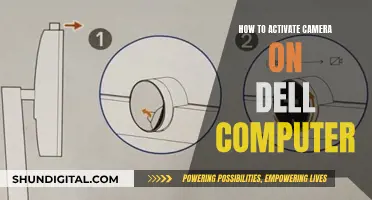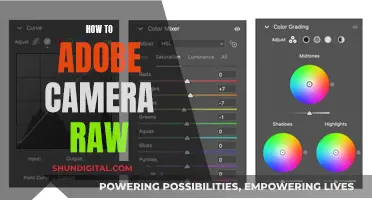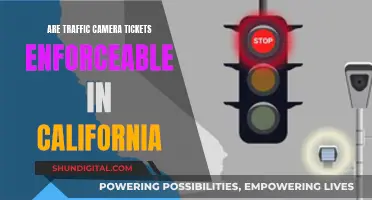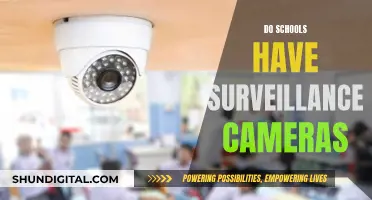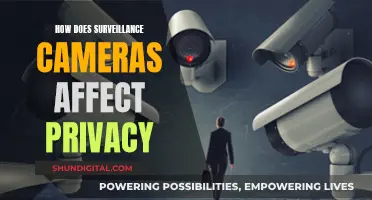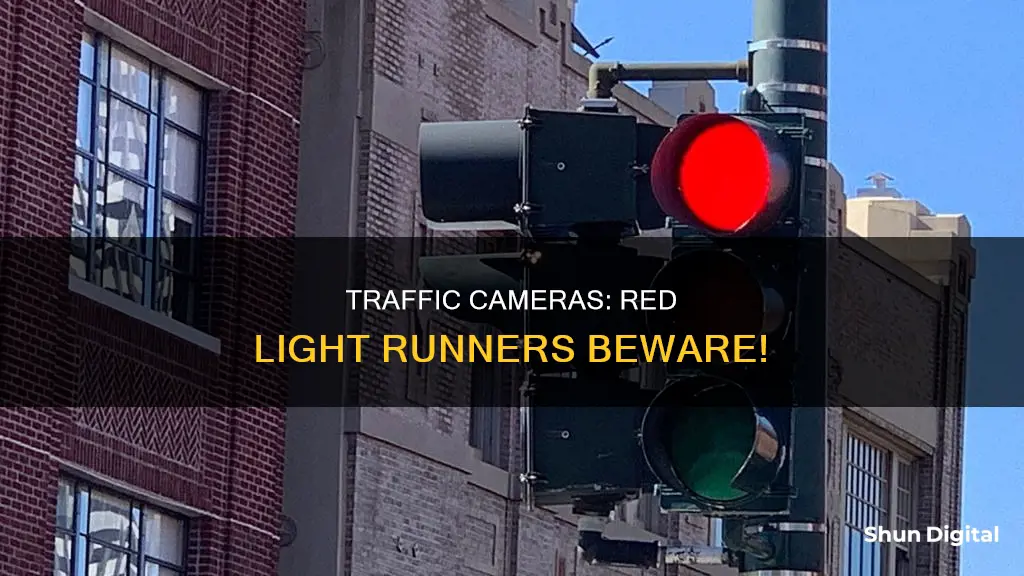
Traffic cameras are an effective way to improve road safety and reduce accidents at intersections. While there are different types of traffic cameras, red light cameras are specifically designed to enforce traffic laws by issuing tickets to drivers who run red lights. These cameras are usually placed at busy intersections and capture images or videos of vehicles that enter an intersection during a red signal. The footage captured by these cameras can be used as evidence in car accident claims, helping to determine who caused the crash and their negligence. However, the use of red-light cameras has been banned in some states, such as Texas, and their presence may vary across different locations.
| Characteristics | Values |
|---|---|
| Purpose | To catch drivers who run red lights and deter them from doing so |
| Functionality | They are triggered by sensors installed in the road that detect when a vehicle passes the stop line during a red light |
| Placement | Busy intersections |
| Appearance | Mounted near intersections; bulky with a large camera box and two external flashes, often on separate poles |
| Number of cameras per intersection | Multiple, to capture angles from different directions |
| Images captured | Multiple images of the car during the violation |
| Notification of violation | Ticket sent by mail or text/email via an app |
| Fine amount | Varies by municipality, e.g. $50 in New York |
| Privacy concerns | Do not violate privacy as driving is a regulated activity and license holders agree to abide by certain rules |
What You'll Learn

Red light cameras are controversial
Red light cameras are a controversial topic. While some people argue that they are an effective way to improve road safety, others believe that they are merely a way for local governments and private companies to generate revenue through traffic fines.
Proponents of red light cameras argue that they help to enforce traffic laws and reduce the number of accidents caused by red light running. Running a red light is a frequent occurrence that often has deadly consequences. In 2022, 1,149 people were killed in crashes involving red light running, with half of those killed being pedestrians, bicyclists, or people in other vehicles hit by the red light runners. An IIHS study found that red light cameras reduced the rate of fatal crashes involving red light running in large cities by 21%. Additionally, the cameras can act as a deterrent, encouraging drivers to comply with traffic laws even when there is no police presence.
On the other hand, critics of red light cameras argue that they are more about generating revenue than improving safety. The fines collected from red light camera violations can bring in significant amounts of money for local governments and the companies that operate the cameras. For example, Florida drivers paid over $100 million in red light camera fines in a single year, and Chicago has collected about $600 million in fines from automated traffic cameras. There is also concern that the presence of red light cameras can lead to an increase in rear-end collisions as drivers stop short to avoid running a red light.
The use of red light cameras has also been associated with concerns about privacy and the role of automated enforcement. Some people view the cameras as an invasion of privacy and a form of "big brother" surveillance. Additionally, the process for reviewing and issuing citations can vary, with some cities using automated systems that may not provide drivers with a fair opportunity to dispute the violation.
The effectiveness and impact of red light cameras are complex and multifaceted. While they have been shown to reduce certain types of accidents, they may also contribute to an increase in other types of collisions. The financial incentives and the potential for abuse of power further complicate the issue. As a result, the use of red light cameras continues to be a highly debated topic, with some states and communities choosing to ban or limit their use.
Quick-Charging Camera Batteries: Efficient Methods to Try
You may want to see also

Cameras reduce red light running
Red light runners cause hundreds of deaths and tens of thousands of injuries each year. In 2022, 1,149 people were killed in crashes that involved red light running. Half of those killed were pedestrians, bicyclists, and people in other vehicles who were hit by the red light runners. In 2022, more than 107,000 people were injured in red light running crashes.
Red light safety cameras are an effective way to discourage red light running. Enforcement is the best way to get people to comply with any law, but it's impossible for police to be at every intersection. Cameras can fill the void. An IIHS study found that cameras reduced the fatal red light running crash rate of large cities by 21% and the rate of all types of fatal crashes at signalized intersections by 14%.
Cameras don’t violate privacy. Driving is a regulated activity, and people who obtain licenses are agreeing to abide by certain rules. Red light safety cameras are a way to catch people who break those rules, just like traditional enforcement.
Red light safety cameras automatically photograph vehicles that go through red lights. The cameras are connected to the traffic signal and to sensors that monitor traffic flow just before the crosswalk or stop line. The system continuously monitors the traffic signal, and the camera captures any vehicle that doesn't stop during the red phase. Many programs provide motorists with grace periods of up to half a second after the light switches to red.
Evidence clearly shows that camera programs are effective at decreasing the number of vehicles running red lights. In one study in Virginia, red light cameras reduced the number of total drivers running red lights by 67%.
However, cameras can have contradictory effects on traffic safety. Some drivers who would have otherwise continued to proceed through the intersection when the light is yellow or red will now attempt to stop. That means that the number of accidents caused by vehicles not stopping at a red light will likely decrease.
But the number of accidents from stopping at a red light – such as rear-end accidents – is likely to increase. That’s not an inconsequential side effect. Some drivers will attempt to stop, accepting a higher risk of a non-angle accident like getting rear-ended, in order to avoid the expected fine.
The overall effect of a camera program on vehicle accidents and injuries depends on the net impact of these two effects. Overall driver safety could increase or decrease.
Charging the Floureon Camera: A Step-by-Step Guide
You may want to see also

Cameras don't violate privacy
Red light cameras are an effective way to discourage people from running red lights, which caused the deaths of 1,149 people in 2022. While some may argue that these cameras violate privacy, this is not the case. Driving is a regulated activity, and by obtaining a license, a motorist agrees to abide by certain rules, such as obeying traffic signals. There is no legal or sensible reason why drivers should not be observed on the road or have their violations documented.
Red light safety cameras do not track when a car goes through a red light. They interface with sensors installed on the road that do the tracking. These sensors are triggered when a vehicle passes the stop line, and the cameras capture any vehicle that doesn't stop during the red phase. In some states, the law prohibits capturing the face of the driver, so only the rear of the vehicle is photographed.
The use of red light cameras has been shown to reduce both red light violations and crashes. Studies have found that these cameras can significantly decrease the frequency of red light violations and reduce the risk of crashes, especially right-angle crashes, which tend to be severe. In the City of Columbus, for example, side-impact collisions at intersections with red-light cameras have decreased by 74%.
While some people may argue that red light cameras violate due process, this is not the case. The tickets are sent to the owner of the vehicle, who may not have been the person committing the violation. This can be addressed through an appeal process, where the accused can provide evidence that they were not driving at the time. Additionally, the use of red light cameras can free up police resources to focus on more violent crimes.
In conclusion, red light cameras do not violate privacy. They are an effective tool to improve road safety and reduce crashes. By obtaining a driver's license, individuals consent to abide by traffic rules and regulations, which include being observed and held accountable for their actions on the road.
Charging Your SP815UZ: Battery Power Basics
You may want to see also

Sensors trigger the camera
Induction loops are the primary, most common, and most reliable type of traffic light sensor. They are preferred in suburban and county road settings because they can effectively manage inconsistent traffic flow and detect when cars arrive at intersections, stack up at intersections, or enter turn lanes.
Other types of sensors used to trigger cameras at traffic signals include microwave radar detectors, video detection cameras, geomagnetic vehicle detection, radar technique, and laser technique.
Microwave radar detectors detect large objects moving towards or away from them and are becoming more commonly used compared to induction loops. Video detection cameras use specialised vehicle detection software to detect cars, and this method is ideal for road surfaces where induction loops cannot be installed, such as gravel or bad road surfaces. Geomagnetic vehicle detection uses changes in magnetic fields on traffic light systems to detect cars, while radar technique detects moving vehicles and is often used for pedestrian detection, and laser technique measures the distance of the vehicle from the intersection or road surface.
Mastering Samsung Camera Focus: Tips and Tricks
You may want to see also

Cameras improve safety
Traffic cameras are an effective way to improve safety on the roads. They act as a deterrent for speeding and red light running, improving safety not only for the vehicle in question but also for other road users, including vulnerable groups such as cyclists and pedestrians. The belief that one will be caught and fined is usually enough to deter people from speeding or running a red light.
Research supports the positive impact of traffic cameras. A study by the Insurance Institute for Highway Safety (IIHS) found that intersections without red light cameras are 30% more likely to have fatal red-light-running crashes than those with cameras. Red light safety cameras were found to reduce fatal red light running crash rates in large cities by 21% and the rate of all types of fatal crashes at signalized intersections by 14%.
In addition to reducing red light violations, traffic cameras can also play a role in reducing the number of fatal car accidents. They encourage drivers to follow traffic laws and stop at red lights, which helps to prevent accidents and improve safety, particularly at busy intersections.
Traffic monitoring cameras are typically placed at strategic locations, such as complex intersections or roads with heavy congestion, to provide a comprehensive view of traffic flow and conditions. These cameras are connected to a control center or network, where their images can be viewed in real time by traffic engineers or law enforcement personnel. This allows for quick incident response and effective traffic management.
The presence of traffic cameras can also help deter people from breaking the rules of the road and make drivers more alert. This, in turn, can help to keep the roads safer for all users.
Focusing Your Camera in Monster Hunter Rise: Tips and Tricks
You may want to see also
Frequently asked questions
Red light cameras are triggered by sensors installed in the road. When a vehicle drives into an intersection and passes the stop line, the sensors trigger the camera to capture images of the car.
If a red light camera catches you, you will receive a ticket in the mail or via text or email if your municipality has an app. The ticket will include a fine, which varies depending on the location and the nature of the violation.
Yes, red light cameras are effective in reducing red light violations and crashes. Studies have shown that red light cameras can reduce red light violations by up to 40% and decrease the rate of fatal crashes at signalized intersections.
Red light cameras are typically placed at busy intersections in urban areas. They are often mounted on poles near the intersection and can be identified by their bulkier size and external flashes.


